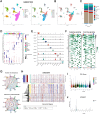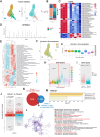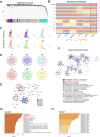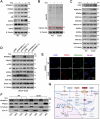Targeting RPS6KC1 to overcome enzalutamide resistance in prostate cancer
- PMID: 40849495
- PMCID: PMC12375275
- DOI: 10.1186/s40364-025-00822-x
Targeting RPS6KC1 to overcome enzalutamide resistance in prostate cancer
Abstract
The androgen receptor signaling inhibitor enzalutamide (Enz) is one the primary therapeutic drugs for advanced prostate cancer (PCa). Nevertheless, most of patients ultimately develop resistance to Enz. Through an integrated analysis of CRISPR genome-wide and kinome-wide screens, coupled with observations of elevated expression levels in Enz-resistant cell lines and PCa tumor tissues, our study identified RPS6KC1 as a novel essential gene implicated in Enz resistance. Mechanistically, our research indicates that the Warburg effect induces H3K18 lactylation, which regulates the expression of RPS6KC1 via the transcription factor P65. Elevated expression of RPS6KC1 was found to recruit PRDX3 to the mitochondria, thereby mitigating ferroptosis. These findings suggest that the H3K18la/NF-κB/RPS6KC1/PRDX3 axis is important for the development of resistance to Enz. Our results suggest that the combination of Enz with targeted RPS6KC1 inhibition or a ferroptosis inducer may represent a promising therapeutic strategy to overcome Enz resistance.
Keywords: Enzalutamide; Prostate cancer; RPS6KC1; scRNA-seq.
© 2025. The Author(s).
Conflict of interest statement
Declarations. Ethics approval and consent to participate: All procedures conducted in this research adhered to the ethical standards set forth by the Ethics Committee of Shanghai Sixth People's Hospital, as well as the 1964 Helsinki Declaration and its subsequent amendments or comparable ethical guidelines. Consent for publication: Not application. Competing interests: The authors declare no competing interests.
Figures





References
-
- Siegel RL, Giaquinto AN, Jemal A. Cancer statistics, 2024. CA Cancer J Clin. 2024;74:12–49. - PubMed
-
- Freedland SJ, et al. Improved outcomes with enzalutamide in biochemically recurrent prostate cancer. N Engl J Med. 2023;389:1453–65. - PubMed
-
- Shafi AA, Yen AE, Weigel NL. Androgen receptors in hormone-dependent and castration-resistant prostate cancer. Pharmacol Ther. 2013;140:223–38. - PubMed
Grants and funding
LinkOut - more resources
Full Text Sources
Miscellaneous

